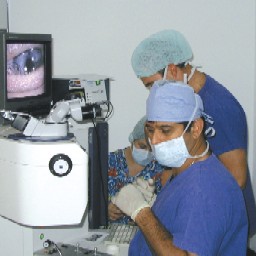This was the message heard by delegates at a special session hosted by Bausch & Lomb, during last month's BCLA clinical conference. This was also the upbeat mood expressed by two of the country's leading consultant refractive surgeons, Mr Deepak Chitkara of Viewpoint Vision Services, Manchester, and Mr Jean-Pierre Danjoux of Site for Eyes, Sunderland, and concurred with by many of the audience.
In a special 'Ask the surgeon' session, delegates were invited to voice any questions or concerns they had about refractive surgery to the panel in a frank and open discussion of a subject that still remains taboo for some practitioners.
The past couple of years have seen a plethora of negative publicity about excimer laser refractive surgery, all of which culminated in the National Institute for Clinical Excellence (NICE) issuing advice about laser refractive surgery.
NICE REPORT
To the uninitiated, it would seem that this report was damning of the refractive sector, but Chitkara explained that patients interested in refractive vision correction were generally unperturbed by the report.
In his experience, patients would question their surgeon about its content, but once the full facts of the report had been explained, the patient generally seemed happy to continue along the course of treatment. Chitkara explained that he believed the foundation of the report was flawed, using data that was out of date and more recent studies had shown quite conflicting results to that presented in NICE's advice.
Danjoux explained that one of the conclusions of the NICE report was that laser refractive surgery was not recommended for NHS patients. He went on to explain that this was due to the perceived risk of corneal ectasia, which was singled out by the report as the greatest risk factor.
Acknowledging that no surgery is without risk, Danjoux explained the risk of corneal ectasia following Lasik was less than 1 in 2,000. In contrast, the risk of endophthalmitis following cataract surgery was much higher, at around 1 in 750. He explained that the risk of ectasia could be further minimised by accurate screening prior to surgery.
Chitkara added an interesting caveat to the discussion by suggesting that NICE's advice may be inaccurate to the private refractive clinic as the very tight protocols and restricted upper limits of treatment (his maximum for myopia was -8D) tend to almost negate the risk of corneal ectasia.
In addressing whether Lasik and laser refractive surgery would ever be available routinely to the NHS patient, Danjoux explained that NICE's advice was due to be reviewed and there were a number of medical indications for their use. These included treating patients with induced anisometropia post-corneal grafting or cataract extraction. However, he reiterated that in the NHS the procedure should be performed for medical reasons and not cosmetic.
One concern expressed by the audience was that there was no indication of the long-term effect of Lasik. The panel dispelled fears and said as a result of high-volume treatments and the fact that the procedure has been performed for more than 10 years, ample data was available, indicating that the procedure was safe.
Moreover, new technology, such as wavefront-guided treatments and faster lasers would further help minimise risk of complications. Arguably, the most troublesome long-term complication of laser surgery was refractive stability. The panel explained that this was a common source of patient dissatisfaction and generally occurred when a patient was treated whose refractive error was not stable.
Danjoux suggested that a good way of determining if refractive change was due to the treatment was to record k-readings following the surgery and then to repeat this in the event of any refractive alteration. If the two readings were the same, then the practitioner could infer that the cornea had not altered and that the refractive change was as a result of change in the axial length or in the crystalline lens.
THE AGEING EYE
The ageing eye was also of concern to the panel. For example, if a patient who had undergone Lasik developed a cataract, calculation of the power of an intraocular lens was more complex than that for a normal eye.
Danjoux explained that although algorithms were in place for such patients, a number of factors needed to be considered, such as the original (pre-Lasik) keratometric readings, and where these were not available some difficulty may arise. The panellist reminded the audience that, as a result of reduced ocular rigidity, the benchmark for monitoring intraocular pressure in glaucoma had to be modified. Chitkara added that increasing dry eye with age might also be a long-term concern in Lasik patients.
Danjoux elaborated that dry eye was arguably the most significant short-term problem following Lasik. This is because the sensory nerve plexus in the cornea is cut during flap creation, thus breaking a nerve loop between the eye, mid-brain, and lacrimal gland, resulting in a temporary loss of reflex tearing.
All patients experienced some symptoms, but severity varied with each patient, and tended to settle, for most, within six months following treatment. The symptoms could be alleviated or relieved by regular use of artificial tears or punctal plugs, explained the surgeon, who added that optometrists were in an ideal position to be involved in the management of the symptoms.
As to which patient was most prone to the severe symptoms, it was impossible to tell, explained the panellist. Preoperative examination to exclude the pathological dry eye was essential agreed both surgeons, but more importantly it would also help determine other, normal patients who were at risk. Danjoux explained that he used a panel of tests, which helped him form an opinion of the specific risk to his patient. These tests included:
Register now to continue reading
Thank you for visiting Optician Online. Register now to access up to 10 news and opinion articles a month.
Register
Already have an account? Sign in here
